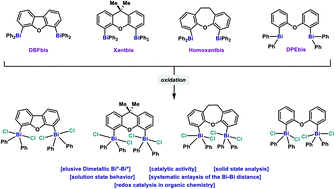Dibismuthanes in catalysis: from synthesis and characterization to redox behavior towards oxidative cleavage of 1,2-diols†
Abstract
A family of aryl dinuclear bismuthane complexes has been successfully synthesized and characterized. The two bismuth centers are bonded to various xanthene-type backbones, which differ in ring-size and flexibility, resulting in complexes with different intramolecular Bi⋯Bi distances. Moreover, their pentavalent Bi(V) analogues have also been prepared and structurally characterized. Finally, the synergy between bismuth centers in catalysis has been studied by applying dinuclear bismuthanes 5–8 to the catalytic oxidative cleavage of 1,2-diols. Unfortunately, no synergistic effects were observed and the catalytic activities of dinuclear bismuthanes and triphenylbismuth are comparable.

- This article is part of the themed collections: p-Block Lewis Acids in Organic Synthesis and Catalysis & biocatalysis in OBC


 Please wait while we load your content...
Please wait while we load your content...